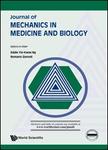版权所有:内蒙古大学图书馆 技术提供:维普资讯• 智图
内蒙古自治区呼和浩特市赛罕区大学西街235号 邮编: 010021

作者机构:Beihang Univ Sch Mech Engn & Automat Beijing Peoples R China Peking Univ Third Hosp Inst Sports Med Knee Surg Dept Beijing 100191 Peoples R China Inner Mongolia Peoples Hosp Dept Orthoped Hohhot 010017 Peoples R China Peking Univ Third Hosp Beijing Peoples R China
出 版 物:《JOURNAL OF MECHANICS IN MEDICINE AND BIOLOGY》 (医学与生物学中的力学杂志)
年 卷 期:2018年第18卷第8期
核心收录:
学科分类:0831[工学-生物医学工程(可授工学、理学、医学学位)] 0710[理学-生物学] 1001[医学-基础医学(可授医学、理学学位)] 10[医学]
基 金:National Hi-Tech Research and Development Program of China (863 Program) [2015AA043204] National Key R&D Program of China [2017YFB13030000] Beijing Science and Technology Planning Projects of Beijing Science and Technology Committee [Z151100003915138] Natural Science Foundation of China [61333019, 81560374]
主 题:Knee joint stereo-vision force sensor posterior cruciate ligament biomechanical properties
摘 要:The main purpose of our study was to evaluate the biomechanics of different posterior cruciate ligament (PCL) reconstruction techniques. Seven fresh cadaver knees were collected. A 6-D OF robot arm was used to test the biomechanical parameters, including the posterior stability, the lateral stability and the rotation stability of different PCL reconstruction techniques. Each group was tested at the knee flexion of 0, 30 degrees, 60 degrees, 90 degrees and 120 degrees, under the following conditions respectively: a posterior force of 134 N, an internal and external rotation torque of 5N . m, a varus and valgus torque of 10N . m, and a combination of 100 N posterior force and 5N . m external rotation torque. The posterior tibia translation and the rotational angle of the 4-tunnel double-bundle PCL reconstruction group were significantly lower than that of 3-tunnel double-bundle group and the single-bundle group;the posterior tibia translation valgus-varus-angle were lower at some specified flexion angle. No statistical difference was found between the anatomic 4-tunnel bundle group and the intact knee group concerning the posterior tibia translation, the rotational angle, and the valgus-varus-angle. This study showed that the biomechanics of PCL of 4-tunnel double-bundle reconstruction was closer to the intact knees than the other two reconstruction methods.